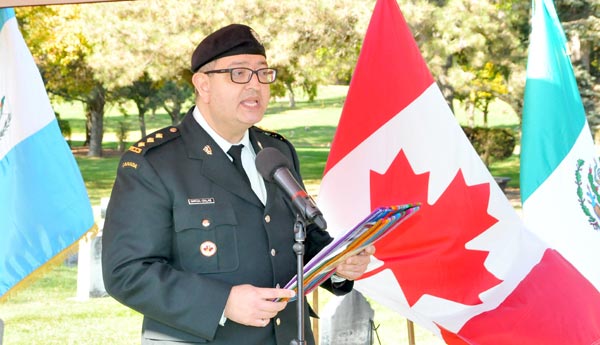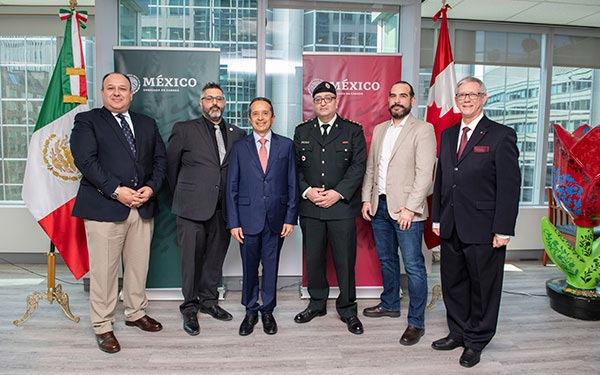

Capt Rey Garcia-Salas
Stag Special
The Latin American community has played a significant role in defending Canadian values and ethics throughout history.
From Confederation on wards, individuals from Latin American countries, including Peru, actively participated in Canada’s military during times of conflict.
This article highlights the remarkable contributions made by Peruvian soldiers who volunteered in the Canadian Armed Forces (CAF) during the First and Second World Wars. Their dedication, bravery, and sacrifice exemplify the shared values between Latin America and Canada, serving as a testament to the strong and lasting bond between the two regions.
Trimer Vic Crothalin: Born in Peru and enlisted in the Canadian Mercantile Marine on the SS Halifax Wreck during the First World War. It was a cargo ship steam propulsion built in 1888. Lost on Dec. 11, 1917 with 37 casualties. Trimer Crothalin’s commitment to serving his newfound homeland is noteworthy.
He joined countless other Peruvians who volunteered to defend Canada’s values, demonstrating the spirit of camaraderie and sacrifice. Trimer Crothalin’s selflessness exemplifies the Latin American community’s dedication to upholding shared principles and the strength of the bond between Peru and Canada.
Sailor A. Velasquez: Born in Peru in 1894, he died on Aug. 13, 1915 as a Canadian Mercantile Marine. Wreck HMS Royal Edward/Canadian Northern Steamships was an invaluable member of the Canadian Navy during the First World War.
Velasquez’s service as a sailor exemplifies the dedication and courage of Latin American individuals who joined the CAF. As a representative of Peru, Sailor Velasquez contributed to protecting Canadian values and promoting international peace. His commitment to the navy reflects the Latin American community’s deep-rooted respect for maritime traditions and the importance of collective defence.
Robert John Lancashire: Born in Peru on Sept. 9, 1891 in Callao, he died on Jan. 16, 1923 in Callao, Peru. His mother was Sofia Francisca Gillis (1868-1925) and his father Lewis Charles Lancashire (1853-1900). Both parents from Callao, Peru.
Before he joined Canadian Expeditionary Force (CEF), he was telegraph and cable operator. Place of enlistment was in United States in New York on Oct. 9, 1918. Unit served 2nd Depot Bn Eastern Ontario Regt (EOR). His demobilization was in Ottawa on Nov. 26, 1918.
He made significant contributions as part of the CEF during the First World War. His enlistment showcases the commitment of individuals from Latin American backgrounds to stand alongside Canadian soldiers. Serving with honour and valour, Lancashire symbolizes the Peruvian soldiers who fought for freedom, justice, and a brighter future for all in this case from Canada due to the First World War ending on Nov. 11, 1918.
Capt Hedley Maurice Harrison: He was born in South Africa, and at age 30 died on Aug. 14, 1944. Cant Harrison was an exceptional leader in the CAF during the Second World War. Joining the Royal Canadian Artillery (RCA), 19 Field Regiment, Capt Harrison, a proud Canadian and son of Ernest Harrison and of Annie Gladys Harrison (nee Anyan), of Lima, Peru, demonstrated his unwavering commitment to defending Canadian values and upholding global peace. He is buried at Bretteville-Sur-Laize Canadian War Cemetery.
During the First World War, the Canadian and Allied merchant ships and mariners of the Merchant Navy played a crucial role in transporting personnel, munitions, weapons, and food to Great Britain and Europe.
This massive undertaking involved navigating treacherous waters, evading German U-boats and mines which claimed the lives of tens of thousands of Allied personnel and thousands of ships. Canada’s Grand Armada, in October 1914, saw more than 31,000 troops transported on 31 ocean liners, escorted by Royal Navy warships, as they sailed for England.
In the face of this daunting challenge, the Royal Canadian Navy (RCN) and the Canadian Merchant Navy rose to the occasion. The RCN, though relatively young and small at the outbreak of the war, expanded significantly by 1918.
Their fleet grew to nearly 9,500 sailors and more than 130 commissioned vessels, including numerous merchant marine vessels and sailors. However, the Canadian Merchant Navy faced a shortage of supply vessels, troop carriers, and trained sailors.
In response, thousands of Canadian merchant sailors, including some Peruvians, bravely left behind the comforts of home and familiar waters to serve their country and fight for freedom abroad.
Trimmers played a vital role in the Merchant Navy. These individuals ensured coal was evenly distributed to maintain the ship’s trim and supplied the firemen with an adequate amount of coal for the boilers.
They performed their duties using shovels, wheelbarrows, and sheer physical strength, often working in cramped and challenging conditions.
The engine room crews, including trimmers, regarded themselves as highly skilled professionals, as their responsibilities were critical to the ship’s operation.
The perils faced by the Canadian Merchant Navy were magnified by the introduction of German U-boats. These submarines silently lurked beneath the surface, posing a significant threat to the merchant ships.
The Canadian Merchant Navy, responsible for transporting troops and essential supplies, became a lifeline for the troops fighting overseas. To mitigate the risk, the convoy system was implemented, grouping merchant ships together and providing them with warship escorts for protection.
Trans-Atlantic convoys, consisting of up to 60 ships, traveled from Eastern Canada to European ports. These efforts were crucial in ensuring that vital resources reached the Allies, ultimately contributing to the Allied victory in late 1918.
The sacrifices made by Peruvians and other members of the Canadian Merchant Navy during the First World War should never be forgotten.
Their dedication, bravery, and selflessness played an instrumental role in safeguarding Canadian and Allied interests. Memorials, such as the Tower Hill Memorial in London, United Kingdom, stand as a testament to the fallen Canadian seafarers, including Vic Crothalin and Sailor A. Velasquez, who lost their lives while serving their country.
The Latin American Soldiers in Canada Committee’s mission is to publicize the names and stories of Canadian Latinos who were part of the CAF. Capt Rey Garcia-Salas is part of the Latin American soldiers who presented the Latin American Soldiers in Canada Remembrance Book Vol I. He’s currently J6-1 with Cyber Forces HQ.
CAF launch Latin American Soldiers in Canada Remembrance Book Vol I
Capo Rey Garcia-Salas
Stag Special
Diversity is a source of strength and resilience in the Canadian Armed Forces (CAF). It is the embodiment of those Canadian values integral to the military ethos and to the effectiveness of the CAF at home and abroad.
The CAF is committed to reflecting the face of Canada’s population among its ranks, reflecting Canadian ideals of multiculturalism, diversity, inclusion, gender equality and respect.
In 2010, Capt Milton Hoyos and Capt Rey Garcia-Salas began organizing and implementing activities within the Defence Team to celebrate Latin American heritage and diversity in the CAF.
Since that time, they have reached out to approximately 1,500 military members and 500 civilian employees over the phone, through e-mails and by word-of-mouth to raise awareness about their heritage and culture.
As part of the celebration for Pan American Day, the Embassy of Mexico co-hosted, with the Latin American Soldiers Committee, the presentation of the Latin American Soldiers in Canada Remembrance Book Vol I in April.
Members from the CAF, DND’s Directorate of History and Heritage members, military attaches from Latin American and abroad, diplomatic members, distinguished guests, and community members were in attendance.
The event offered those with Latin American roots an opportunity to connect and embrace their heritage in Canada. Attendees also had an opportunity to learn more about the role that Latin Americans have played in the defence of Canada since the First World War.
The Mexican Ambassador in Canada, Carlos Joaquin Gonzalez, spoke of community initiatives which have helped support and promote a better understanding of Latin American history and the role that Mexicans and Latin Americans have played in shaping the world we’ve inherited.
This was followed by a panel discussion chaired by the Mexican Consul Juan Gabriel Morales with guests Nick McCarthy and Capt Rey Garcia-Salas (Latin American soldiers committee in Canada), and historian Dr. Andre Levesque (retired CAF and Veterans Affairs).
Creation of the Latin American Soldiers in Canada Remembrance Book was managed by editorial director Nick McCarthy and design director Giuseppe Marconi, while Capt Garcia-Salas took care of content production.
The introduction to the book was written by Mexican Consul Juan Gabriel Morales and Military attaché of Mexico to Canada Gen German Alejandro Frias Moreno.
For soldiers of Latin-American heritage, the CAFs’ story of multiculturalism, diversity and inclusion is not a new initiative. It began generations ago when Latin-Americans took up arms to serve in the First World War.
It was just the beginning for the integration that is a key component of the CAFs’ culture and protocols.
Left to right: Mexican Consul Juan Gabriel Morales panelist panel moderator; Nick McCarthy Latin American soldiers committee panelist; Ambassador of Mexico Carlos Joaquin Gonzalez; Capt Rey Garcia-Salas CAF and Latin American soldiers committee panelist; Giuseppe Marconi Latin American soldiers; and Dr Andre Levesque historian panelist plus CAF and Veterans Affairs retired.


